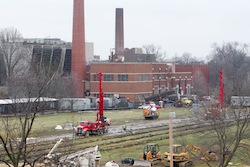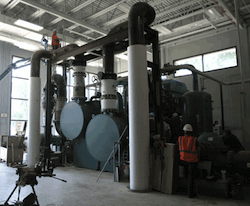 It’s been while since I’ve written about geothermal so I thought I’d bring you this neat story from Ball State. The university created the country’s largest ground-source, closed-loop district geothermal energy system. The project began in the Spring of 2012 when water heated by the Earth began flowing through a geothermal district heating and cooling system.
It’s been while since I’ve written about geothermal so I thought I’d bring you this neat story from Ball State. The university created the country’s largest ground-source, closed-loop district geothermal energy system. The project began in the Spring of 2012 when water heated by the Earth began flowing through a geothermal district heating and cooling system.
This portion of the project will enable Ball State to reduce the load on four of its aging coal-fired boilers. This is just the first phase. When the entire project is complete, the boilers will be shut down and one result will be the reduction of campus carbon emissions by nearly half. At full capacity, the geothermal system will heat and cool 47 buildings with an estimated energy savings of $2 million per year.
 So how was the geothermal system put into place? Nearly 3,600 boreholes will be drilled in borehole fields around campus. During Phase 1, 1,800 boreholes were drilled an an equal number will be drilled during Phase 2. An eyesore you think? No! Once construction is complete they will not be seen and the campus will remain as beautiful as it was before the project begun.
So how was the geothermal system put into place? Nearly 3,600 boreholes will be drilled in borehole fields around campus. During Phase 1, 1,800 boreholes were drilled an an equal number will be drilled during Phase 2. An eyesore you think? No! Once construction is complete they will not be seen and the campus will remain as beautiful as it was before the project begun.
Ball State says that this project has national implications: ground-source geothermal energy can be used in every state. The geothermal project was dedicated as part of an ongoing sustainability initiative and educational series, the Greening of the Campus IX: Building Pedagogy. The conference allows a diverse group of people to share information and ideas on environmental issues. With the success of the geothermal project, I’m curious to see what neat energy projects Ball State comes up with next.

